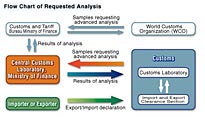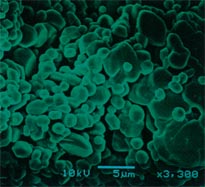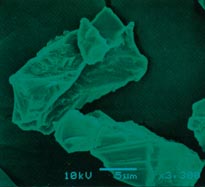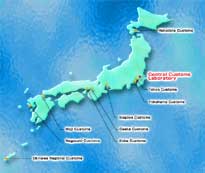Requested Analysis -Analysis Requested by Customs-
At present, nine Customs and a total of 200 Customs branch offices and subbranch offices have been established in Japan. The Analysis Department of each Customs analyzes imported items as requested. If the Analysis Department comes across an imported item that is too difficult or impossible to analyze, it requests the CCL to conduct the analysis. When the CCL receives an analysis request from a Customs, the CCL considers what will be the most appropriate analysis method for the item and then examines the item using highly sophisticated knowledge and high-performance analysis equipment. The chemist that has examined the goods compiles a report on the analysis result. Each Customs classifies the goods on the basis of the report.
*Click on the graphic to see a larger one.

Flow Chart of Analysis Service
![]()
Analysis of Food, Agricultural and Marine Products
The duty rate varies for dairy products, marine products, rice and grains, and meat depending on their type and level of processing. Also, because some of these products are subject to import restrictions, they must be analyzed with high precision and sensitivity.
(Note: Some products are subject to import restrictions if the restriction applies in terms of the composition of such products.)
Analysis of Sugars, Organic Acids, and Vitamins
Because the duty rate varies depending on the sugar content of concentrated juices and the protein, fat and sugar composition of preparations of milk and flour, high-performance liquid chromatography and other methods are used to identify the ingredients and analyze their composition.
Analysis of Meat and Species
Meat is judged by using an electrophoresis apparatus to identify the kinds of proteins. At this stage, it is possible to distinguish whether the meat comes from some of the whales covered by the Washington Convention or from beef, which is quite similar. Even for meat from the same kind of animal, DNA analytical instruments make it possible to determine the specific animal species by examining the DNA base sequence.
Analysis of Inorganic Compounds
To determine the duty rate to be applied to products processed using natural minerals and metals, qualitative, quantitative and structural analyses are conducted on their chemical elements. Non-destructive methods are employed to analyze precious metals, etc., to prevent damage to them.
Crystal Structure Analysis
X-ray diffractometry is employed to analyze the crystal structures of minerals and metals.
Analysis of Elemental Composition
X-ray fluorescence spectrometry and ICP emission spectrometry are used for alloys and mineral products such as salt, in which the duty rate depends on the amount of the elements contained, and to identify and determine the amount of elements contained in the products.
Analysis of Processed Products with Identical Elemental Composition and Crystal Structure
A scanning electron microscope (SEM) is used to analyze substances such as charcoal and activated carbon or aluminum oxide and artificial corundum, in which the elemental composition and crystal structure are identical but the duty rate varies depending on the degree of processing.

Aluminum oxide, other than artificial corundum
(magnification x 3,300)

Artificial corundum
(magnification x 3,300)
Analysis of Organic and Other Compounds
Qualitative, quantitative and structural analyses are conducted on the chemical composition of plastics, petroleum products, perfumery, chemicals, surface-active agents, textiles and paper, for which the duty rate depends on the degree of processing. High-performance analytical instruments are used to analyze substances such as synthetic resins with complex chemical compositions, and new pharmaceuticals.
Analysis of Plastics and Synthetic Pharmaceuticals
Prior to determining the molecular structure of plastics and other polymer compounds, GPC is used to divide the components according to their different molecular sizes. An infrared spectrophotometer is used to determine the molecular structure and chemical composition quickly and accurately.
Advanced Molecular Structure Analysis
To determine molecular structure and chemical composition, a nuclear magnetic resonance spectrometer is used to examine the combined state of hydrogen, carbon, nitrogen, and other atoms.
Analysis of Volatile Substances
Substances that are capable of forming gases are separated by gas chromatography, and the substances are identified from their molecular mass with a mass spectrometer. This instrument is also used to identify trace elements such as the musk contained in perfumery.
Requested Analysis
Research and Development
Technical Guidance

